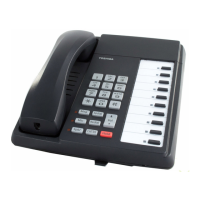
Do you have a question about the Toshiba DKT3010-SD - Digital Phone and is the answer not in the manual?
| Type | Digital Phone |
|---|---|
| Model | DKT3010-SD |
| Display | Yes |
| Number of Programmable Keys | 10 |
| Speakerphone | Yes |
| Headset Port | Yes |
| Color | Black |
| Speed Dial | Yes |
| Caller ID | Yes |
| Volume Control | Yes |
| Display Lines | 2 |
| Compatible Systems | Toshiba Strata DK, CIX |
Describes the structure of the manual for easy navigation and understanding of its content.
Provides an overview of the DKT3000 series digital speakerphones, listing various models.
Describes the standard, non-programmable buttons on the dial pad for quick access to functions.
Explains the programmable buttons that can be assigned various features for customization.
Details the LCD screen's functions, information display, and control buttons.
Introduces the IPT1020-SD Internet Protocol Telephones and their features.
Introduces the DKT2000 series digital speakerphones and their models.
Details the programmable buttons for the DKT2000 series, noting screen size differences.
Describes the LCD for the DKT2000 series, noting screen size differences.
Advises users to check with their CTX System Administrator for system-specific features.
Explains the different types of 'Line' options available on the phone.
Helps users identify their system's specific outgoing/incoming call handling features.
Details the three methods for originating a call: Hot Dialing, Speaker, and Handset.
Explains how to answer incoming calls using the handset, speaker, or handsfree.
Guides users on how to view and retrieve message waiting indications.
Explains the operation and settings of the telephone microphone.
Describes the procedures for transferring calls to other extensions or voice mail.
Explains how to set up and manage conference calls with multiple participants.
Details how to place calls on hold and retrieve them.
Explains how to adjust handset, speaker, and ring volumes.
Explains how to navigate and use the phone's LCD screen for various functions.
Defines the functions of the soft keys and how they relate to LCD prompts.
Illustrates the practical application of soft keys with step-by-step examples.
Guides users on setting and clearing advisory messages for LCD telephones.
Explains the use of account codes for billing, tracking, and line restriction.
Details how voluntary account codes are used and validated.
Explains how to automatically redial a busy number at intervals.
Describes how to set up automatic callback for busy stations or lines.
Explains how to enable and cancel background music playback.
Introduces system and station call forwarding features.
Lists different categories for setting call forwarding.
Describes various settings for call forwarding (All Calls, Busy, No Answer).
Explains button sequences for programming call forwarding.
Provides practical examples for setting up call forwarding.
Explains how to view call history using Caller ID.
Describes the feature for temporarily holding calls in specific locations.
Explains how to pick up calls ringing at other stations.
Details how external callers can access the system directly.
Explains how to set unique ringing patterns for different call types.
Guides users on activating and deactivating the DND feature.
How to manage DND settings for other extensions.
Explains how to use the door unlock feature via telephone buttons.
Describes how to use and answer door phone calls.
Explains how to cancel echo on the IPT1020-SD telephone.
Provides instructions on how to make an emergency call.
Explains how stations can be automatically directed to emergency destinations.
Details how to change the display language on the telephone.
Explains how to prevent call monitoring for privacy.
Describes how to make calls to busy extensions with announcements.
Introduces various features that allow overriding normal call restrictions.
Introduces the DKT3014-SDL telephone with its large screen display.
Explains how to access and use directory and speed dial lists.
Details the use of system and personal speed dial features.
Explains how to search internal and external directories for contacts.
Guides on saving names for personal speed dial entries.
Explains how users can customize telephone features by programming buttons.
Details how to enter and exit the user programming mode.
Lists the codes used to assign functions to flexible buttons.
Step-by-step guide to programming flexible buttons.
Explains how to use and create one-touch buttons for quick access.
Explains the meaning of LED indicators on telephone buttons.
Provides a list of feature access codes for various telephone functions.
Introduces the DADM and its capability to add buttons.
Details DADM models, their functionalities, buttons, and LEDs.
Introduces the DSS console for additional buttons and its operations.
Explains the functionality and status indicators of DSS buttons.
Describes DSS call transfer to busy stations and answering outside calls.
Explains DSS console usage for speed dial and paging announcements.
Details overriding call forward and using the night transfer button via DSS.
Explains Centrex extension numbering and matching.
Describes accessing Centrex features via programmable buttons.
Explains programming ring delays for incoming calls.
Defines the functions of programmable feature buttons.
Continues the definitions of programmable feature buttons.
Provides steps to reset the IPT1020-SD telephone to default settings.
Details the process for configuring network settings for the IPT phone.
Explains how to adjust various phone functions like beeps and noise cancellation.
Guides on adjusting the headset transmit volume levels.
Explains how to view terminal information like firmware and MAC address.